I was very grateful to get the opportunity last month to return to Laguna San Ignacio in Baja California Sur, Mexico to visit the friendly gray whales for the third year in a row. The lagoon remains just as magical with every visit. If you ever want to make this journey for yourself, I can't recommend
Baja Discovery high enough. Not only is their camp in *the* prime location where you can and hear gray whales and bottlenose dolphins at all hours, but their staff is knowledgeable, accommodating, entertaining, and continually go above and beyond on all levels.
There's nothing quite like coming face to face with a gray whale mom and calf, especially when the size of the mother dwarfs the size of the panga you're on.
It's a rare thing to have wild animals, let alone an animal as intelligent as a whale, seek out interactions with people. While some may be skeptical this can be done safely for both whales and people, the whole scene is incredibly well managed by the local fishermen in the lagoon who have strict regulations in place and self-police each other. What goes on in San Ignacio is an amazing phenomenon, and also a prime example, in my opinion, of ecotourism done right.

After having encounters like these with gray whales, it's no wonder that people who live or visit San Ignacio Lagoon love these animals. They also tend to have negative feelings towards killer whales, because coastal transient orcas from Mexico to Alaska prey upon gray whale calves as they make their first migration up the coast after leaving the protected Mexican lagoons. I've heard people say that a third of calves or more might be taken by orcas before making it to their summer feeding grounds. Indeed, in the two weeks or so since we saw orcas in Monterey Bay, at least 3 gray whale kills have been observed there, as between 20 and 30 orcas are feeding there!
The whole view is quite a contrast to the San Juan Islands, where orcas (admittedly it's mostly the fish-eating ones) are beloved and gray whales are seen as boring. It's pretty interesting to go back and forth between these two places. Having had the Baja encounters, it's safe to say I'm not in the "gray whales are boring" camp!
This year, I also had the opportunity to follow the gray whales on part of their migration, as after returning to San Diego from Baja, I got to road trip up the coastal highway back to San Juan Island. It gave me a new appreciation for just far these whales are traveling. They make the longest trek of any mammal - 10,000 to 12,000 miles round trip - from the Baja breeding lagoons to the Bering and Chukchi Seas where they feed during the summer months. That is a long way to travel at 2-6 mph, especially considered it's believed they make the trip mostly without eating.
Here's a map showing where I got to see gray whales on their northbound migration this year, in 7 places ranging from San Ignacio Lagoon to Cape Meares, Oregon.
Thinking about the whales traveling all those miles we drove (and flew, to get back to San Diego) was amazing. Even more astounding was thinking that for some whales, this represented just half the distance they had to go!
Another thing that I noticed on my travels is how beloved the gray whale is along the entire west coast, even where people aren't having close encounters with them. For the most part, when the whales are migration, all you get to see of them is, at best, the small puff of their blow and maybe a little back:
 |
| Two gray whales off Big Sur, California |
This is why they're thought of as boring (or at least less interesting) in the San Juans, where killer whales surface a lot, have impressive dorsal fins, and tend to be very surface active. (To be fair, the Puget Sound gray whales - a small group that returns every spring - do have a devoted following as well.) Along a lot of the coast, the above photo is all the casual whale watcher will get to see of a whale. Perhaps it's because during the peak of the migration you only have to spend a few moments scanning in any given location to find a whale, but everywhere we went up the coast from Mexico to California through Oregon there were various tributes to the gray whale:
 |
| Gray whales painted on shells in Mexico |
 |
| Gray whale mosaic globe at a cafe in Laguna Beach, CA |
 |
| Gray whale painting in Big Sur, California |
 |
| Life size gray whale model at the Monterey Bay Aquarium in California |
 |
| Gray whale drawing at Point Reyes, California |
 |
| Gray whale mail box near Yachats, Oregon |
 |
| Gray whale mural in Depoe Bay, Oregon |
While I don't dislike orcas - even the ones who make their living eating gray whales - after experiencing these amazing whales in so many places, you can certainly count me as another gray whale admirer!



















































